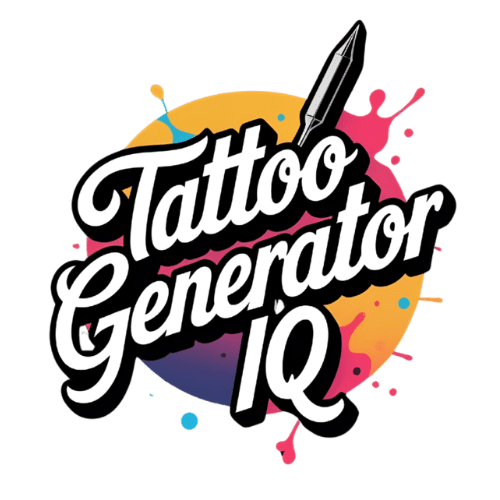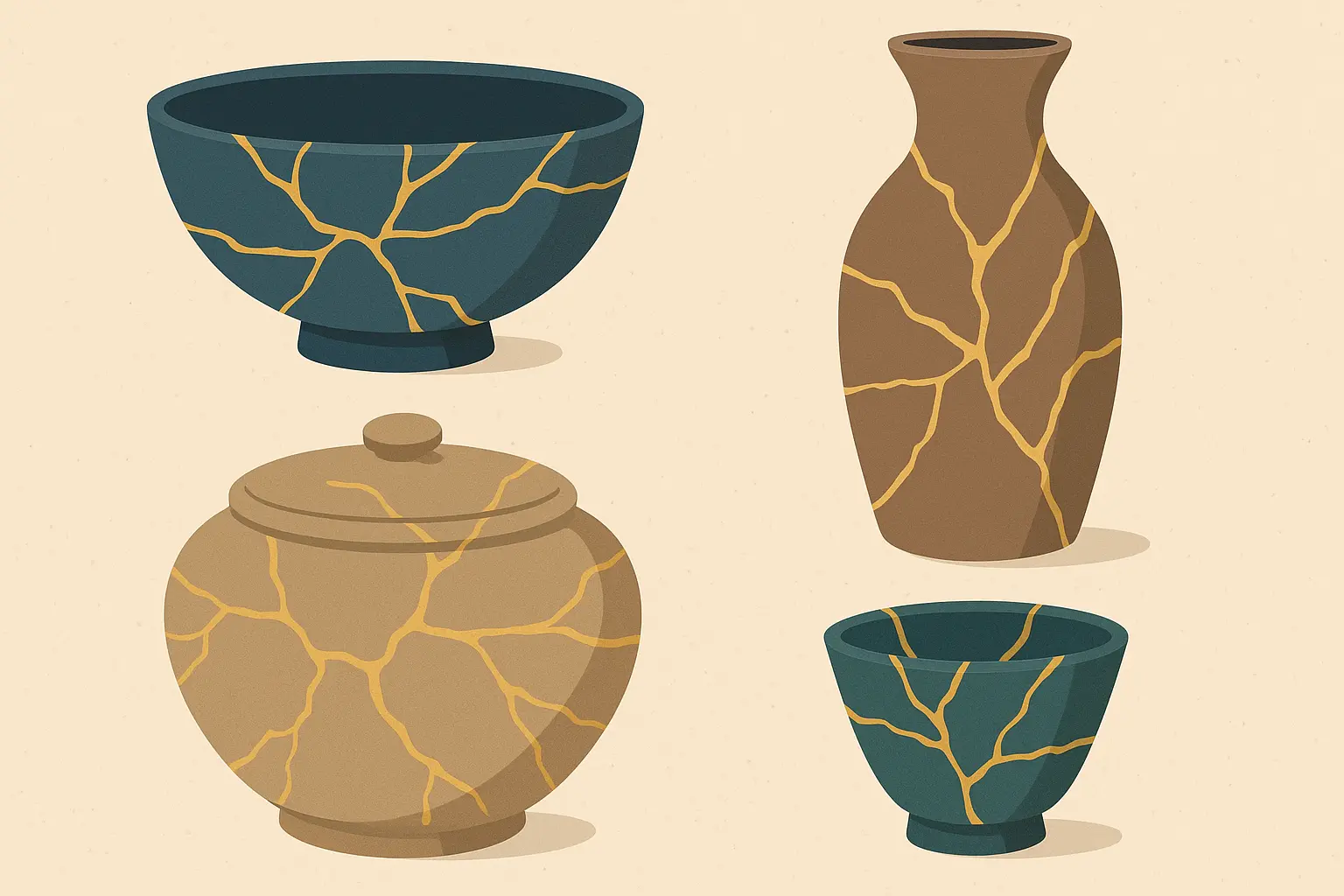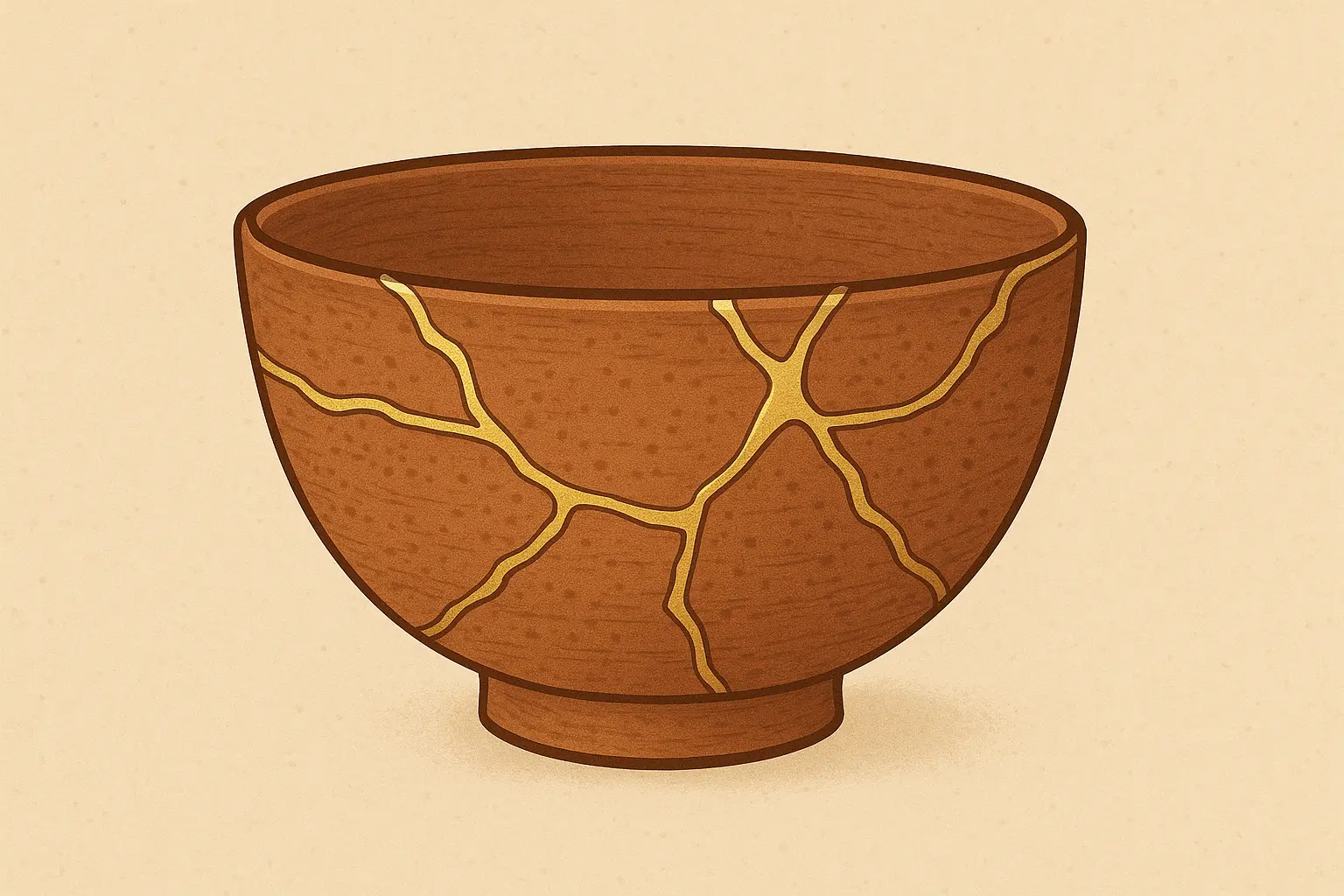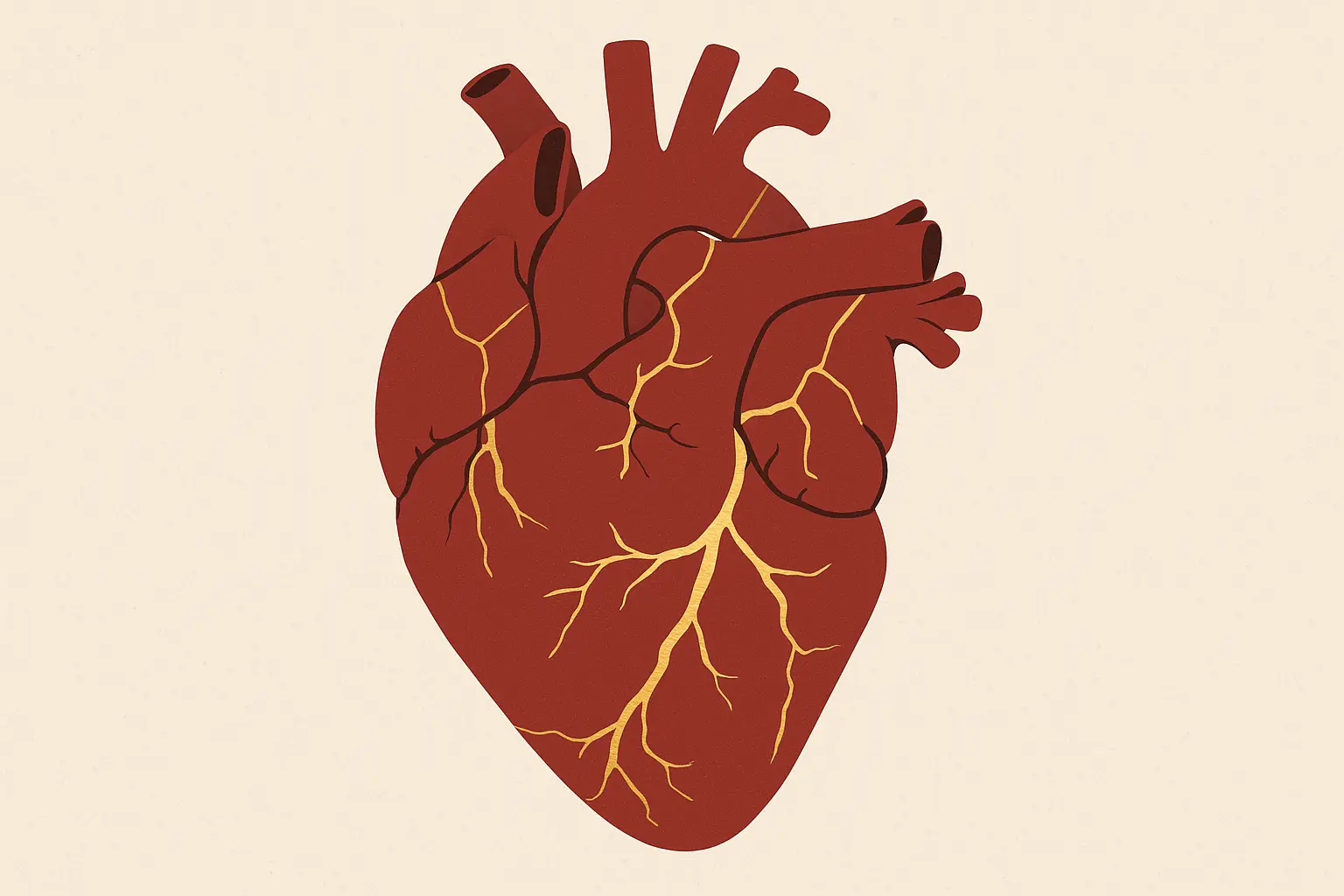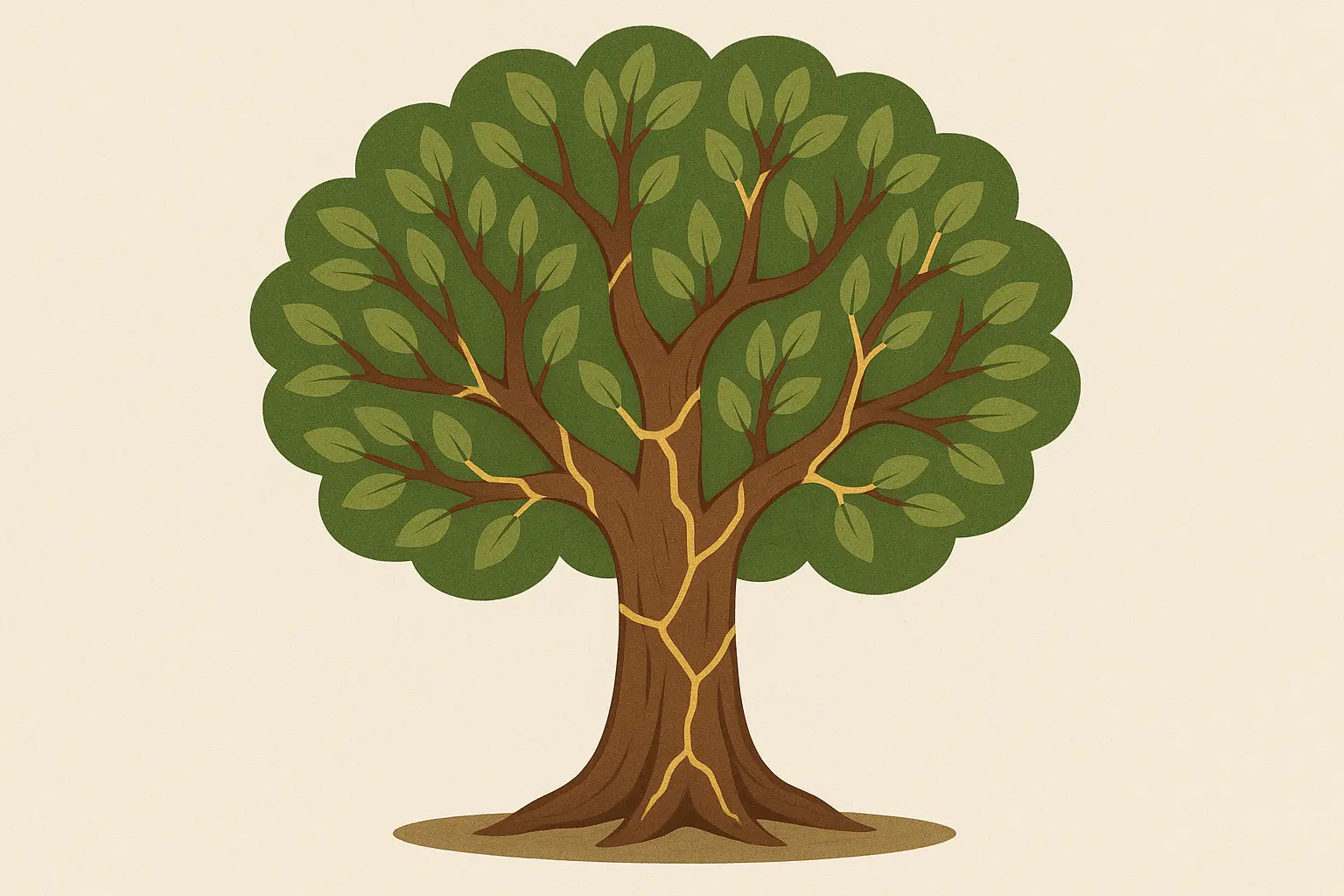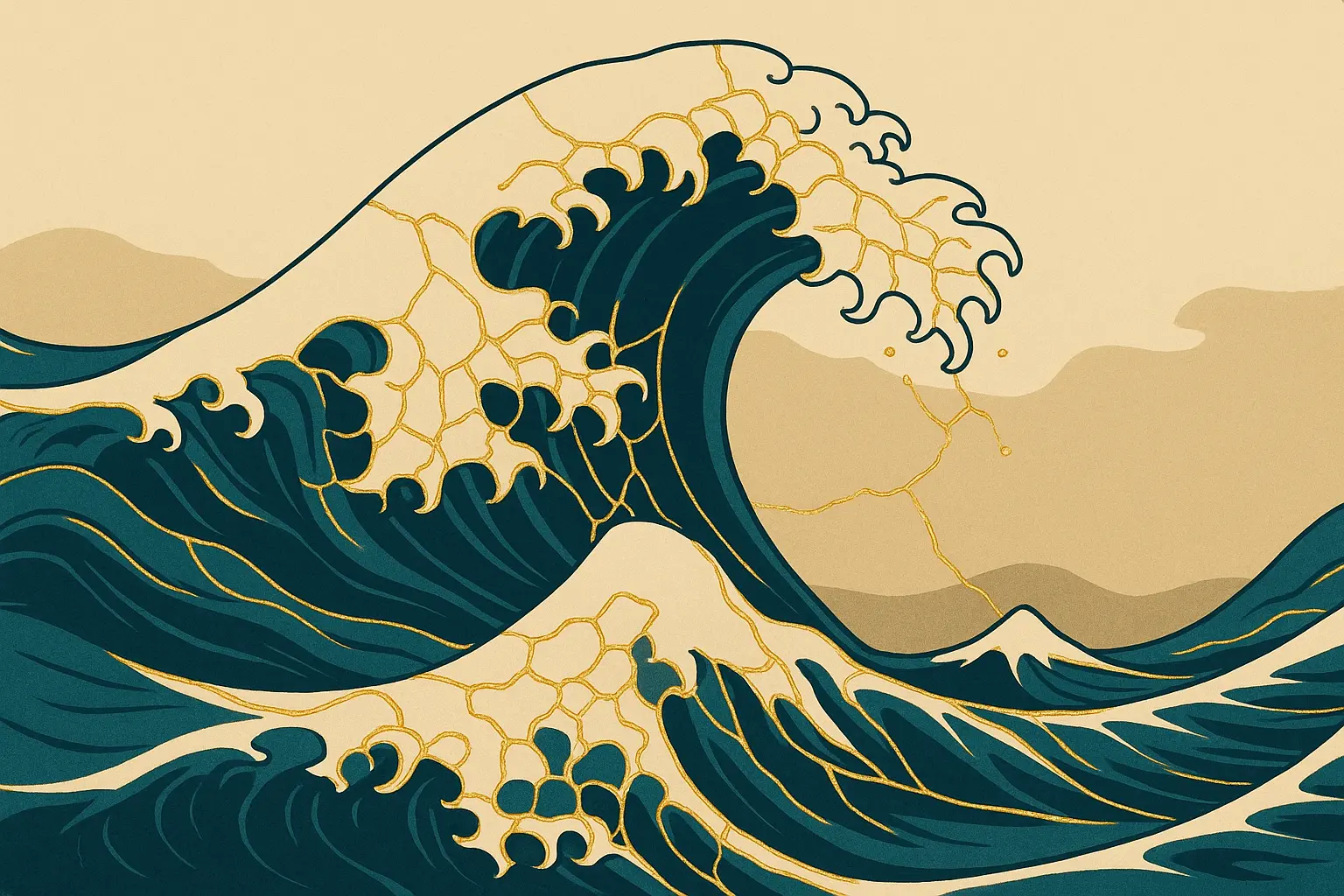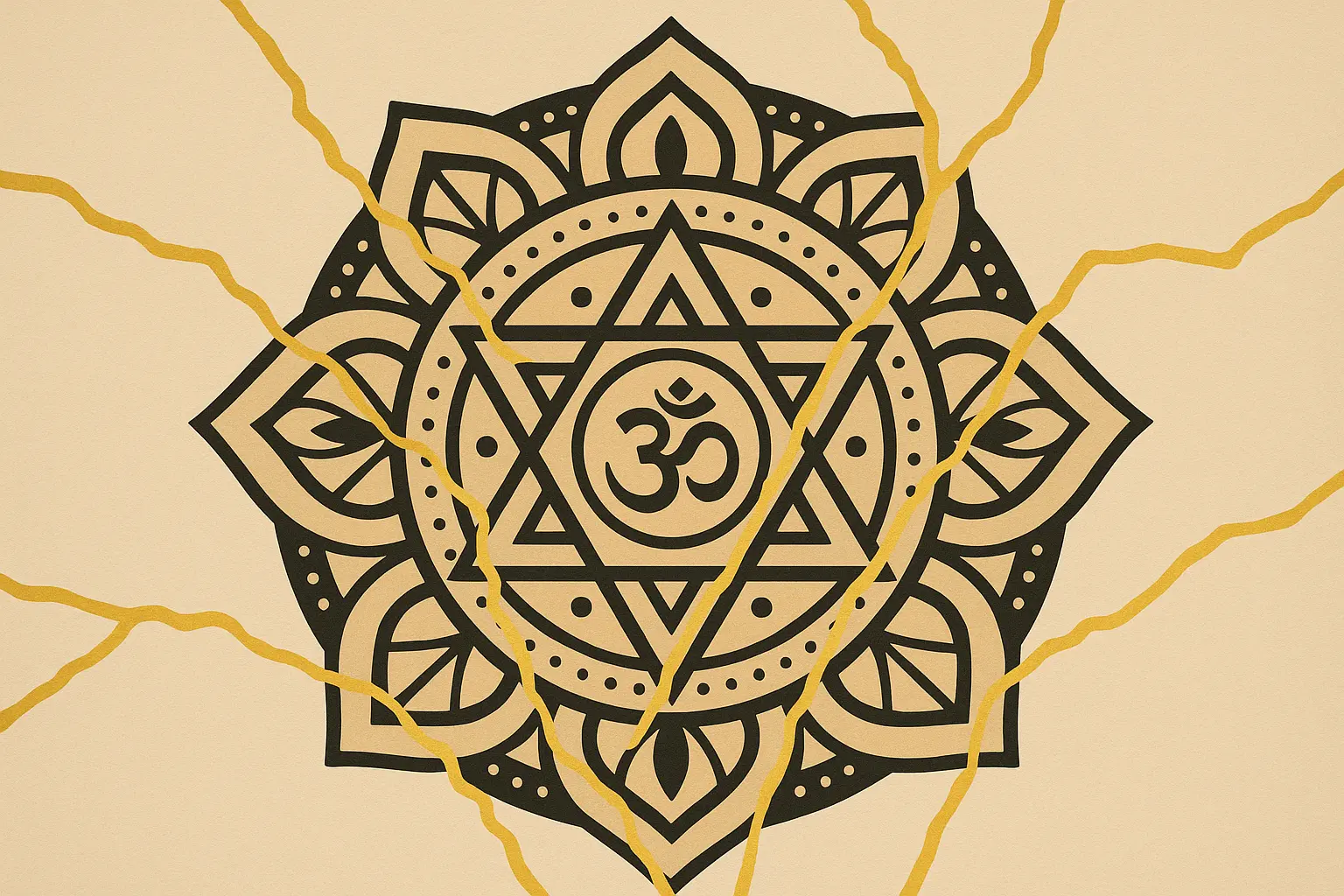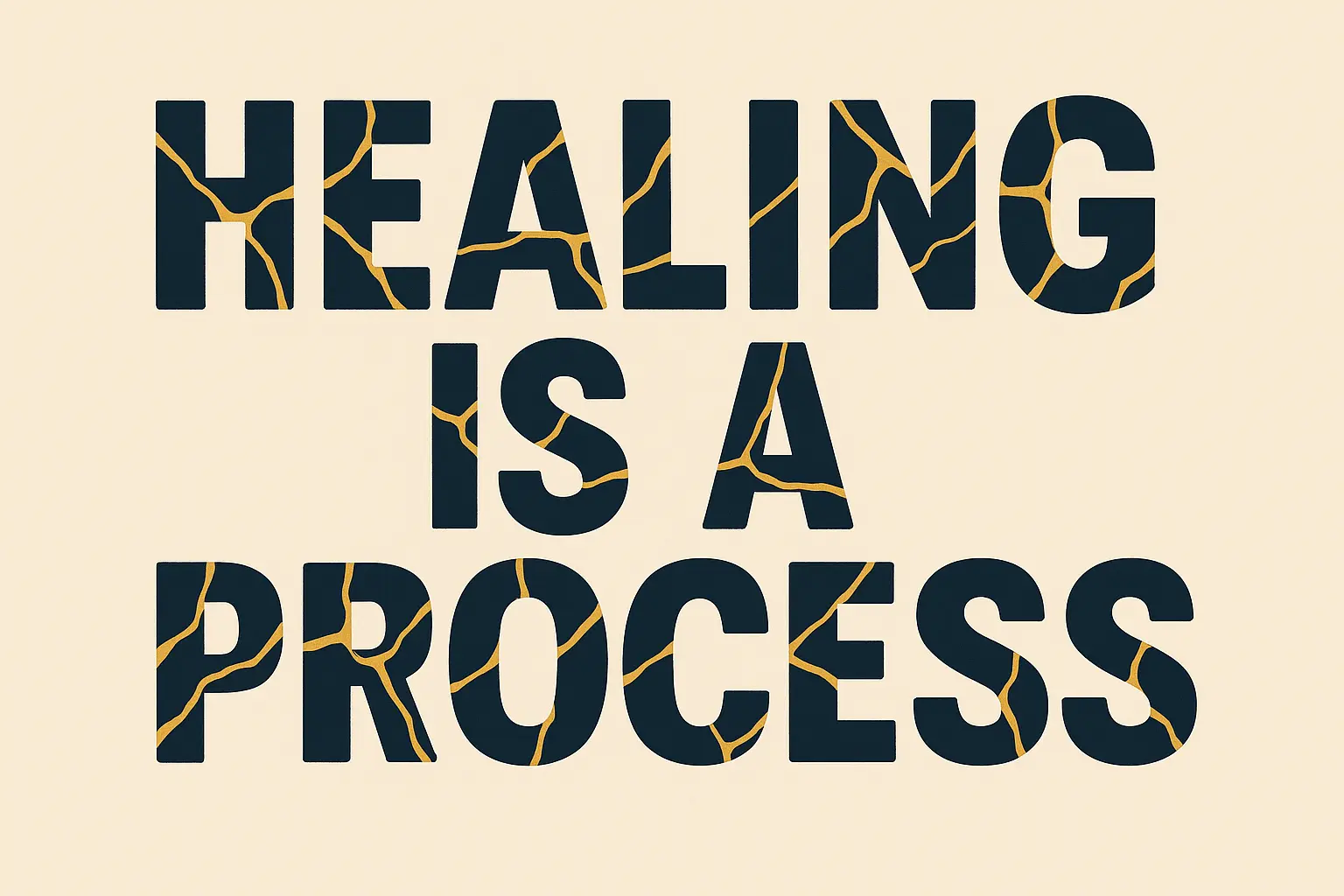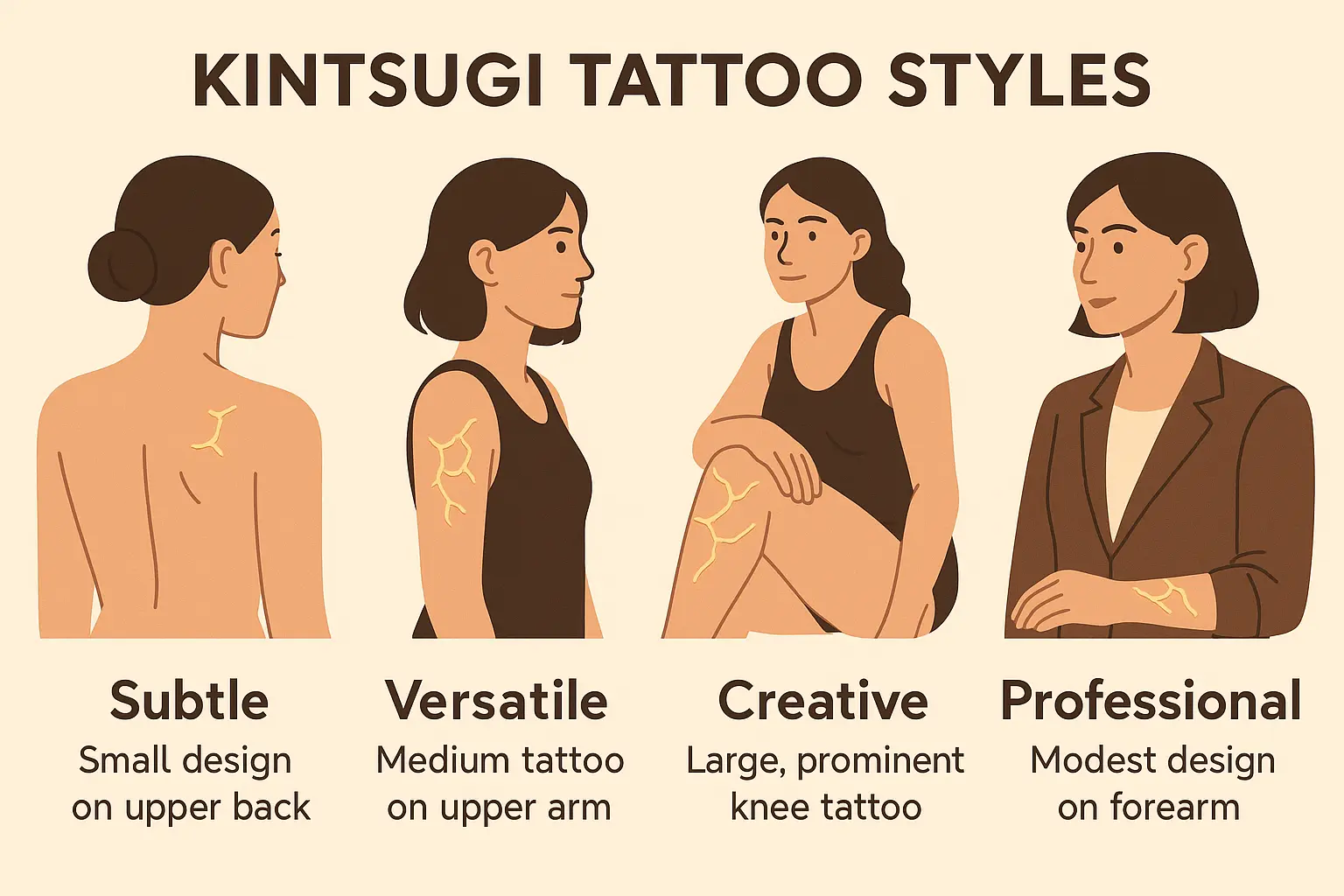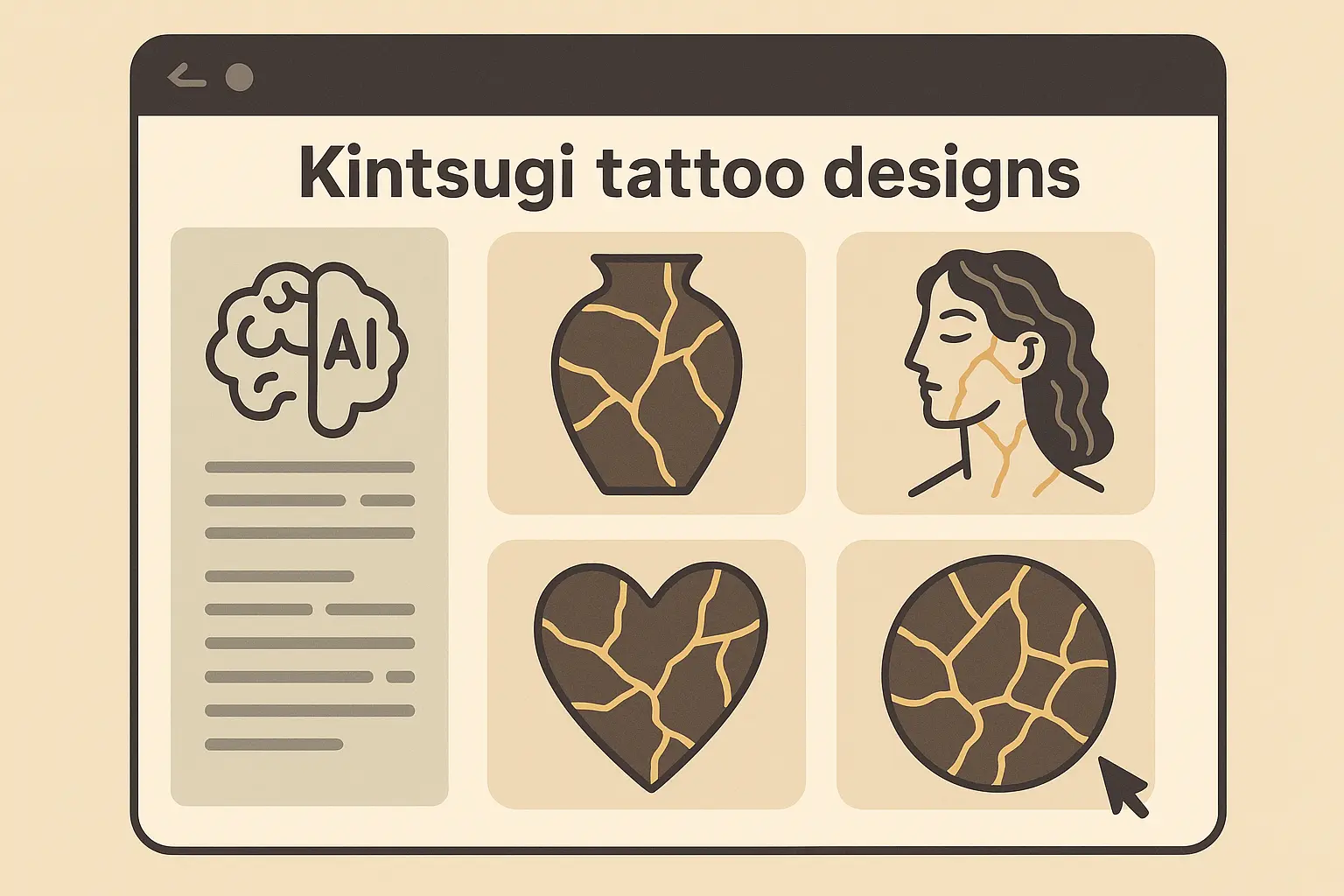25 Stunning Kintsugi Tattoo Designs That Transform Your Scars Into Golden Art

I stumbled across a powerful story on Journeying Beyond Breast Cancer that completely changed how I think about scars and healing. During those quiet lockdown months when the world felt frozen, someone discovered how the ancient Japanese philosophy of kintsugi could transform their physical breast cancer scar into something really beautiful. Reading about their journey made me realize how many of us carry both visible and invisible scars that could use some golden repair.
Kintsugi tattoos have become incredibly popular because they represent something we all need: the courage to see our broken places as sources of strength rather than shame. These designs celebrate the Japanese art of repairing broken pottery with precious metals, creating something more beautiful than the original. Your scars, whether physical or emotional, don’t have to be hidden anymore.
Just like understanding how tattoo meanings evolve in our digital age, kintsugi tattoos represent a modern interpretation of ancient wisdom. The beauty of kintsugi tattoos lies in their versatility – you can choose from traditional pottery-inspired designs, anatomical interpretations that honor your body’s healing journey, nature-based symbols of growth, or modern geometric patterns. Each approach offers a different way to tell your story of resilience and transformation.
Table of Contents
-
Essential Considerations Before Getting Your Kintsugi Tattoo
-
Traditional Pottery-Inspired Kintsugi Designs
-
Anatomical and Body-Inspired Kintsugi Tattoos
-
Nature and Organic Kintsugi Interpretations
-
Geometric and Modern Kintsugi Approaches
-
Cultural and Spiritual Fusion Designs
-
Text and Word-Based Kintsugi Tattoos
-
Matching Your Design to Your Lifestyle
-
How Tattoo Generator IQ Can Perfect Your Vision
-
Final Thoughts
TL;DR
-
Kintsugi tattoos transform the Japanese art of golden pottery repair into powerful symbols of personal healing and resilience
-
25 distinct designs span six categories: traditional pottery, anatomical, nature-inspired, geometric, cultural fusion, and text-based approaches
-
Your personal connection and meaning should drive your design choice more than just how pretty it looks
-
Placement affects both what it means to you and practical stuff like whether your boss will care and how it’ll age
-
Finding the right artist is crucial – look for someone who’s good with fine lines, geometric work, or knows about the culture
-
Size matters for how well the crack patterns and gold effects will show up and look good over time
-
Color choices affect how much upkeep you’ll need – traditional gold requires touch-ups every few years
-
Complex designs need multiple sessions and cost more but create more dramatic results
Essential Considerations Before Getting Your Kintsugi Tattoo
Look, getting a kintsugi tattoo isn’t just about choosing a design you think looks cool. You’re making a permanent statement about your journey through tough times and your commitment to finding beauty in broken places. The decisions you make now will affect how you feel about this tattoo for decades to come.
Understanding pain levels for different tattoo placements becomes especially important when considering kintsugi tattoos, since these designs often work best in areas that might hurt more than you’d expect.
Here’s the thing – your personal connection to the kintsugi philosophy should be the foundation of every other choice. What parts of it really speak to you? Are you celebrating recovery from trauma, embracing physical imperfections, or marking a major life change? The Japanese concept teaches that breakage and repair become part of an object’s history rather than something to hide. Your kintsugi tattoo should authentically represent your own story of growth through tough times.
First, think about what this tattoo actually represents for you. What trauma or healing does this symbolize? That’s going to determine everything from the design category to the specific symbolism you want. If you work in a conservative field, can this be easily covered when needed? That affects where you put it and how big you make it. Be honest about your pain tolerance – how many sessions can you realistically handle? This influences how complex and detailed you can go.
Budget is a big one that people don’t always think through. What’s your total investment capacity? This determines not just size and complexity, but also what tier of artist you can afford. And fair warning – the maintenance commitment is real. Will you actually keep up with color touch-ups? Because that affects your color palette and ink choices. Think about body changes too – how will aging or weight changes affect this tattoo? That influences where you put it and how flexible the design needs to be.
Placement decisions carry both practical and symbolic weight. Kintsugi tattoos work beautifully in various spots, but each offers different meanings and challenges. Curved areas like shoulders, ribs, or thighs can emphasize how organic those crack lines look, while flat surfaces like forearms or back provide excellent canvases for detailed work. Think about how the golden crack lines will flow with your body’s natural shape and how the placement will age with your body over time.
Sarah’s Story: After surviving a car accident that left visible scars on her forearm, Sarah chose a kintsugi-inspired design that actually incorporated her real scar tissue into golden crack patterns. Working with an artist who had experience with scar cover-ups, she created a 6-inch design that transformed her trauma reminder into a symbol of strength. Sarah admits the first session was way more painful than she expected, and she had moments of doubt during the healing process. The placement on her forearm allows her to see it daily for personal motivation while still being professional-appropriate with long sleeves when needed. Some days she loves how it catches the light, other days she worries about explaining it to people who don’t get it – and that’s totally normal.
Whether your boss will care matters more than you might think at first. While society has become more accepting of tattoos, certain careers still have restrictions. Think about whether you need the option to cover your kintsugi tattoo easily or if you’re comfortable with it always being visible. This decision affects both placement and size.
How tricky the design is to tattoo directly impacts your budget, pain tolerance, and upkeep needs. Simple designs with clean lines age gracefully and need less touch-up work over time. Complex pieces with intricate shading and color work create stunning visual impact but need more care and potentially more sessions to complete properly.
Color palette decisions affect both immediate visual impact and long-term upkeep. Traditional kintsugi uses gold, but tattoo interpretations can incorporate various metallic effects, black and white contrasts, or colorful artistic approaches. Gold ink requires special consideration as it may fade differently than traditional black ink and might need touch-ups every 5-7 years to maintain its luminous quality. Not gonna lie – it can be finicky and expensive to maintain.
Finding an artist can make or break your kintsugi tattoo experience. Not every talented tattoo artist excels at the precise line work and shading techniques required for effective kintsugi designs. Look for artists with experience in geometric work, fine line tattoos, or Japanese-inspired pieces. Review their portfolio specifically for examples of detailed repair patterns and metallic effects. Trust me on this – finding an artist who really gets kintsugi can be tough, but it’s worth the search.
Size considerations directly impact how well the details show up and how they’ll age. Kintsugi tattoos rely heavily on the visibility of crack patterns and repair lines. I’ve seen people regret going too small with these designs – very small tattoos may lose detail over time as the ink naturally spreads slightly under the skin. Larger pieces allow for more intricate storytelling through the crack patterns but require more time, money, and skin real estate.
Traditional Pottery-Inspired Kintsugi Designs
Traditional pottery-inspired kintsugi tattoos offer the most authentic representation of the original Japanese art form. These designs feature realistic ceramic vessels, bowls, cups, and vases with visible crack patterns filled with golden repair lines. They require experienced artists capable of rendering pottery textures and metallic effects while maintaining the philosophical integrity of the kintsugi tradition.
1. Classic Ceramic Bowl with Gold Veins
This design represents the most authentic interpretation of kintsugi philosophy. The realistic ceramic bowl shows visible crack lines filled with gold, creating an organic web pattern that tells a story of damage and beautiful repair. The design typically measures 4-6 inches and works beautifully on forearms, shoulders, or thighs where the curved surface can complement the bowl’s natural shape.
Similar to traditional Japanese tattoo designs, this kintsugi pottery tattoo requires an artist who understands both cultural significance and technical execution.
This one’s moderately challenging to tattoo – your artist needs to understand ceramic textures and be skilled with metallic ink techniques. Gold kintsugi tattoo effects may need periodic touch-ups every 5-7 years to maintain their luminous quality. This design is excellent for those wanting authentic kintsugi representation and serves as a great choice for first-time kintsugi tattoos.
It works best for people whose healing involved accepting help from others, since the bowl serves as a vessel for receiving support. The forearm placement allows daily visibility for personal reminder and reflection on your journey. Some people worry about explaining the symbolism to others, but most find that the beauty of the design speaks for itself.
2. Broken Vase Reconstruction
A tall ceramic vase with prominent vertical and horizontal crack patterns emphasizes the vessel’s continued functionality despite its breaks. This design symbolizes ongoing purpose after trauma and works best for larger placements like the back, thigh, or ribcage where the vertical composition can be properly proportioned.
This one’s pretty challenging – multiple crack intersections require mathematical precision in their placement. Black and white versions age better than full-color approaches and require fewer touch-ups over time. The design demands an artist with portfolio examples showing complex geometric line work and shading gradients.
This kintsugi tattoo perfectly represents major life rebuilding situations like divorce, career changes, or addiction recovery. The large scale (8-12 inches) is essential for proper crack pattern visibility and artistic impact, making it a significant commitment both financially and physically. Don’t underestimate how much this will cost or how long it’ll take to complete.
3. Tea Cup with Delicate Cracks
The intimate nature of a traditional Japanese tea cup with fine crack patterns makes this ideal for smaller, more personal placements like wrist, ankle, or behind-the-ear locations. The design emphasizes the beauty in everyday objects made precious through repair, creating a subtle but meaningful reminder of your healing journey.
This looks simple but it’s actually pretty hard to pull off well – fine line specialists are essential for crack detail preservation at this smaller scale. Single-color approaches are recommended for small scale longevity, as complex color work may blur together over time.
The personal connection works beautifully for quiet healing, daily ritual establishment, and mindfulness practice. The small scale (2-3 inches) limits detail but creates an intimate, personal reminder that you can carry with you always. Just remember that tiny details might not age as well as you hope.
4. Sake Set with Multiple Pieces
An artistic composition showing several connected ceramic pieces – cups, bottles, and serving vessels – all featuring complementary crack patterns. This kintsugi tattoo works well as a larger back piece or sleeve element, representing community healing and shared experiences through difficult times.
Heads up – this one’s very challenging due to multiple elements needing visual balance and flow across the composition. Limited color palettes maintain cohesion across multiple elements and age more gracefully than complex color schemes. Artists need composition skills and understanding of Japanese ceramic traditions.
This design represents community healing, family recovery, and group therapy success. The large scale (10+ inches) is necessary for multiple element readability and artistic coherence, making it suitable for those with extensive healing journeys involving community support. Yeah, it’s going to cost more than a regular tattoo – those multiple elements and gold effects don’t come cheap.
5. Abstract Pottery Fragments
A modern interpretation showing floating pottery fragments with golden connections creates a deconstructed view of the kintsugi process. The design emphasizes the transformation aspect of the philosophy, showing pieces coming together in new configurations rather than simply repairing old ones.
This one requires contemporary artistic vision beyond traditional tattooing approaches. Gradient gold effects enhance the floating, transformative feeling but require artists experienced with advanced shading techniques. The abstract nature might need explanation to people who aren’t familiar with kintsugi.
Perfect for non-linear healing, creative transformation, and artistic souls who see their healing as an ongoing creative process. Medium scale (6-8 inches) balances abstract readability with placement flexibility on shoulders or ribcage areas.
Anatomical and Body-Inspired Kintsugi Tattoos
Anatomical kintsugi tattoos merge medical illustration accuracy with the golden repair aesthetic, creating powerful symbols for physical and mental health recovery. These designs require artists with anatomical knowledge and the ability to integrate crack patterns without compromising the recognizability of body structures. They work exceptionally well for those whose healing journey involved medical challenges or mental health recovery.
6. Kintsugi Heart Tattoo
The anatomical heart features realistic crack patterns with gold repair lines, symbolizing emotional healing and the beauty of a heart that has loved and lost. This design typically incorporates medical illustration accuracy with artistic kintsugi elements, creating a powerful statement about emotional resilience.
This one’s pretty tough – you need anatomical accuracy plus artistic crack integration. Red heart with gold cracks creates striking contrast but needs color maintenance every 5-7 years. Artists with medical illustration backgrounds are preferred for anatomical precision and proper proportion.
Chest placement (4-6 inches) aligns symbolically with your actual heart location. This kintsugi heart tattoo powerfully represents relationship trauma, loss recovery, and emotional healing journeys. The medium scale allows anatomical detail while fitting chest placement naturally. You might worry about explaining this to people who don’t get it, but the symbolism usually speaks for itself.
7. Kintsugi Brain Tattoo
A detailed brain illustration with kintsugi crack patterns represents mental health recovery, neuroplasticity, and the beauty of a mind that has overcome challenges. The design often incorporates neural pathway imagery with golden repair lines, celebrating the brain’s ability to heal and adapt.
This is very challenging – your artist needs neuroanatomical knowledge and fine detail capability. Grayscale with gold accents maintains medical illustration feel while adding the kintsugi aesthetic. Behind-ear or scalp placement (3-5 inches) creates intimate medical symbolism.
Exceptional for mental health recovery, learning disability acceptance, and neuroplasticity celebration. This kintsugi brain tattoo works at moderate scale necessary for brain structure recognition and crack visibility while maintaining the intimate nature of mental health symbolism.
Michael’s Journey: Following his recovery from depression and anxiety, Michael chose a kintsugi tattoo brain design placed behind his ear. The 4-inch piece features anatomically correct brain structures with subtle golden crack patterns representing neural pathway healing. His artist specialized in medical illustrations, ensuring the brain’s complexity was preserved while integrating meaningful repair symbolism that speaks to his mental health journey. Michael admits he was nervous about the placement and worried people might think it was weird, but he says it’s become his favorite reminder of how far he’s come. Even the best artists sometimes have to go back and fix little details, and his required one small touch-up session.
8. Skeletal Hand with Golden Joints
An artistic representation of hand bones with kintsugi-style golden joints and crack repairs symbolizes the strength found in vulnerability and the beauty of aged wisdom. The design celebrates the body’s ability to heal and adapt through time and challenge.
This one’s challenging – you need bone structure accuracy with joint detail precision. Bone white with gold joints creates elegant, medical aesthetic that ages well. Artists need anatomical illustration experience for proper bone proportion and joint placement.
Hand or forearm placement (5-7 inches) provides anatomical alignment with actual bone structure. Perfect for arthritis acceptance, aging gracefully, and physical rehabilitation stories. Larger scale is needed for bone detail accuracy and joint crack visibility.
9. Ribcage with Repair Lines
A partial ribcage illustration featuring kintsugi crack patterns across the bone structure, often placed over the actual ribs for anatomical alignment. The design represents protection of the heart and vital organs despite past damage, creating a powerful shield metaphor.
This is very challenging – you need understanding of chest anatomy and curve work. Monochromatic approaches emphasize structure over decoration and age more gracefully. Large scale (8-10 inches) is essential for ribcage proportion accuracy and crack detail.
Ideal for life-threatening illness recovery, protection symbolism, and vital organ healing. Don’t let anyone tell you this won’t hurt – ribcage placement is no joke, but it’s symbolically powerful, representing the protection of what matters most despite past damage.
Nature and Organic Kintsugi Interpretations
Nature-inspired kintsugi tattoos blend organic forms with golden repair patterns, representing growth through adversity and the healing power of natural cycles. These designs work well with body contours due to their organic shapes and offer widely understood symbolism through trees, flowers, mountains, and water elements. They appeal to those who find healing through connection with nature.
10. Kintsugi Tree with Golden Bark Cracks
A tree illustration where the bark features kintsugi-style golden crack patterns represents growth through adversity and the beauty of weathered strength. The design often includes roots and branches that incorporate the repair aesthetic, showing how damage can become part of natural beauty.
This one’s moderately challenging – your artist needs botanical illustration skills plus geometric precision for crack patterns. Earth tones with gold accents enhance the natural feeling while maintaining the kintsugi aesthetic. Back or thigh placement (8-12 inches) accommodates proper tree proportions.
Excellent for growth through adversity, family healing, and root establishment stories. Large scale allows root system detail and branch crack visibility, making this perfect for those whose healing involved reconnecting with nature or establishing new foundations.
11. Butterfly Wings with Repair Patterns
Delicate butterfly wings featuring kintsugi crack patterns suggest the transformation process itself involves necessary breaking and rebuilding. The design emphasizes metamorphosis and the beauty of change while maintaining the delicate nature of butterfly symbolism.
This is pretty tricky – you need wing detail plus crack integration without destroying the delicate appearance. Traditional monarch colors with gold cracks maintain butterfly recognition while adding the repair aesthetic. Artists need insect illustration experience with fine line capability.
Shoulder blade placement (4-6 inches) allows wing spread naturally across the curved surface. Perfect for transformation, metamorphosis, and delicate strength stories. This kintsugi butterfly tattoo works at medium scale to balance wing detail with crack pattern visibility.
12. Mountain Range with Golden Fault Lines
A landscape design showing mountains with geological fault lines rendered in kintsugi style connects personal healing to natural processes. The design represents the beauty of tectonic forces and the strength found in geological time scales, putting personal struggles into natural perspective.
Moderately challenging – your artist needs landscape skills plus geological accuracy for realistic fault line placement. Natural mountain colors with metallic fault lines create striking contrast. Artists need landscape tattooing experience with geometric line work capability.
Across shoulders or back placement (10-14 inches) accommodates landscape format properly. Ideal for those finding strength in nature, geological time perspective, and stability. Large scale is essential for mountain proportion and fault line detail visibility.
13. Flower Petals with Crack Patterns
Individual flower petals or whole blooms featuring kintsugi-style repair lines suggest that even delicate beauty can be strengthened through careful mending. The design often incorporates seasonal flowers with personal significance, adding layers of meaning to the repair symbolism.
Moderately challenging – you need botanical accuracy with crack integration that doesn’t overwhelm the delicate flower structure. Natural flower colors with subtle gold crack accents maintain botanical recognition. Artists need botanical illustration skills for proper petal structure and proportion.
Forearm or ankle placement (3-5 inches) provides delicate placement that matches the flower’s natural delicacy. Perfect for delicate healing, seasonal growth, and feminine strength. Medium scale maintains petal detail while showing crack patterns clearly.
14. Ocean Waves with Golden Foam
Stylized ocean waves where the foam and spray are rendered in golden kintsugi style represent the constant motion of healing and the beauty found in turbulent waters becoming peaceful. The design captures the dynamic nature of emotional healing processes.
This one’s challenging – you need water movement illustration plus foam texture rendered as crack patterns. Ocean blues with gold foam effects create dynamic contrast that captures both movement and repair. Artists need water illustration experience with texture work capability.
Ribcage or thigh placement (6-10 inches) accommodates wave movement and flow. Excellent for emotional flow, cleansing, and constant motion healing. Large scale is needed for wave movement and foam detail visibility.
Geometric and Modern Kintsugi Approaches
Geometric and modern kintsugi interpretations focus on clean lines, abstract patterns, and contemporary artistic approaches while maintaining the core philosophy of beautiful repair. These designs age excellently due to their simplified forms and appeal to those preferring modern aesthetics over traditional imagery. They offer professional discretion while still carrying deep symbolic meaning.
15. Minimalist Kintsugi Lines
Clean, geometric crack patterns without representational imagery focus purely on the aesthetic of golden repair lines across skin. The design emphasizes the philosophy through pure form rather than symbolic objects, creating a modern interpretation that works in professional environments.
This looks simple but requires steady hand for clean lines – geometric specialists are essential for line precision and mathematical accuracy. Single metallic color ages excellently and requires minimal touch-ups.
Highly scalable design works anywhere (2-8 inches) due to its abstract nature. Perfect for those preferring subtle symbolism, modern aesthetic, and professional discretion. This kintsugi tattoo minimalist approach makes this an excellent choice for first kintsugi tattoos or those testing their comfort with visible tattoos.
Similar to other fine line tattoo designs, minimalist kintsugi tattoos require artists with exceptional precision and steady hands.
16. Mandala with Kintsugi Elements
Traditional mandala patterns that incorporate kintsugi crack lines suggest that even sacred geometric forms can be made more beautiful through breaking and repair. The design combines spiritual symbolism with healing philosophy, creating layered meaning for meditation practitioners.
This is very challenging – you need mandala precision plus crack integration without disrupting the sacred geometry. Traditional mandala colors with gold crack accents maintain spiritual symbolism. Artists need sacred geometry experience for proper mandala construction and proportion.
Back or thigh placement (6-10 inches) accommodates circular composition properly. Ideal for spiritual practice, meditation, and sacred geometry appreciation. Large scale is necessary for mandala detail and crack visibility without compromising either element.
17. Architectural Kintsugi
Building or structural elements featuring kintsugi repair patterns represent the rebuilding of life foundations and the beauty of reconstructed stability. The design might include bridges, foundations, or architectural details that speak to structural healing and rebuilding.
This one’s challenging – you need architectural accuracy plus crack integration that makes structural sense. Structural materials (concrete, steel) with gold repair lines create realistic contrast. Artists need technical illustration skills for proper architectural proportion and detail.
Forearm or back placement (6-12 inches) depends on the architectural element chosen. Perfect for life rebuilding, foundation work, and structural healing. Scale depends on architectural element but must accommodate both structural detail and crack visibility.
18. Circuit Board Kintsugi
A modern interpretation showing electronic circuit patterns with kintsugi-style golden repairs represents the integration of technology with ancient wisdom and the beauty of repaired connections in our digital age.
This one’s challenging – you need circuit accuracy plus crack pattern integration that follows logical electronic pathways. Green circuit board with gold trace repairs creates authentic electronic aesthetic. Artists need technical precision and modern aesthetic understanding.
Forearm or shoulder placement (4-8 inches) provides technical visibility appropriate for the modern symbolism. Excellent for tech professionals, digital age healing, and modern connection repair. Medium scale is needed for circuit detail and crack visibility.
Cultural and Spiritual Fusion Designs
Cultural and spiritual fusion kintsugi tattoos honor the Japanese origins while incorporating elements from other spiritual traditions or cultural backgrounds. These designs require cultural sensitivity and often carry complex layered meanings that speak to multicultural healing experiences or deep spiritual practice combined with the kintsugi philosophy.
19. Kintsugi Kanji Tattoo
Japanese characters related to healing, strength, or beauty, rendered with kintsugi crack patterns integrated into the calligraphy. The design honors the cultural origins while creating personal meaning through text, requiring careful balance between readability and artistic crack integration.
This is very challenging – you need calligraphy accuracy plus crack integration without destroying character recognition. Traditional black ink with gold crack accents maintains cultural authenticity. Artists need Japanese calligraphy knowledge for proper stroke order and proportion.
Forearm or back placement (4-8 inches) ensures character visibility and cultural respect. Perfect for honoring Japanese culture, language learning, and calligraphy appreciation. This kintsugi kanji tattoo must be large enough for character recognition and crack detail without compromising either element.
Lisa’s Cultural Connection: Having studied Japanese language and culture for years, Lisa chose the kanji for “strength” (力) with subtle golden crack patterns woven through the brushstrokes. Her artist, who specialized in Japanese calligraphy tattoos, spent extra time ensuring the character maintained its proper proportions while integrating meaningful crack lines that enhanced rather than disrupted the traditional form. The 5-inch design on her forearm serves as both cultural appreciation and personal strength reminder. Lisa admits she worried about cultural appropriation, but working with a knowledgeable artist helped her create something respectful and meaningful.
20. Zen Circle with Cracks
The traditional ensō (Zen circle) featuring intentional breaks repaired with golden kintsugi lines represents the imperfect perfection of enlightenment and the beauty of spiritual practice through difficulty. The simple form allows focus on meaningful crack placement.
Moderately challenging – you need circle precision with meaningful crack placement that enhances rather than detracts from the Zen symbolism. Traditional black circle with gold cracks maintains spiritual authenticity. Artists benefit from understanding Zen philosophy for proper execution.
Circular form fits anywhere (4-8 inches) due to its simple, adaptable shape. Ideal for meditation practice, imperfection acceptance, and spiritual growth. Medium scale balances circle impact with crack visibility.
21. Lotus with Repair Lines
A lotus flower emerging from water, with kintsugi crack patterns across the petals, represents the Buddhist concept of beauty arising from muddy conditions combined with the Japanese aesthetic of beautiful repair. The design bridges multiple spiritual traditions.
This one’s challenging – you need botanical accuracy plus spiritual symbolism understanding. Traditional lotus colors with gold accent cracks maintain spiritual recognition while adding repair symbolism. Artists need botanical skills plus spiritual symbol understanding.
Back or thigh placement (6-10 inches) accommodates full lotus representation with proper proportion. Perfect for spiritual growth, rising above difficulty, and Buddhist practice. Large scale is needed for lotus petal detail and crack integration.
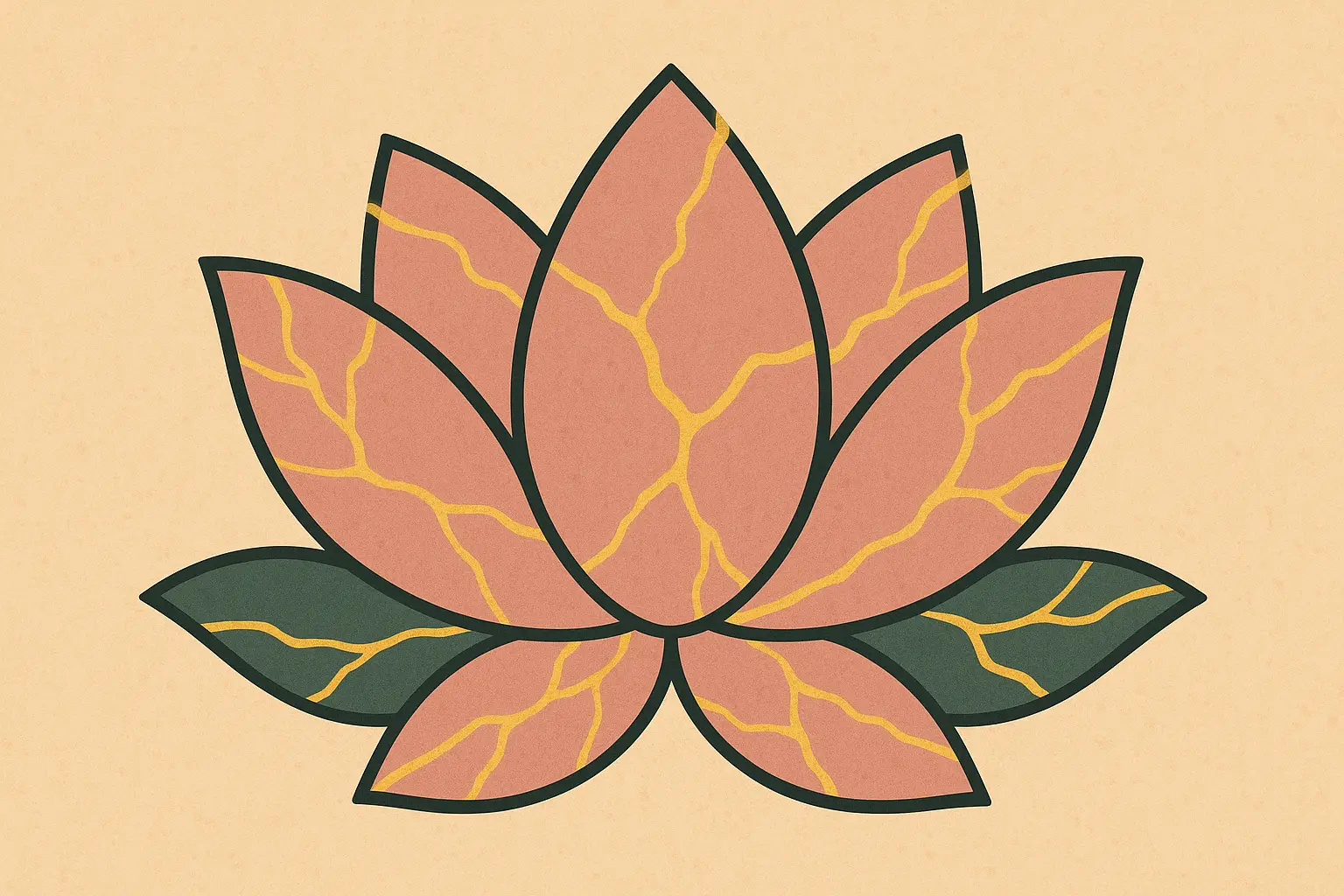
22. Phoenix with Golden Fractures
A phoenix rising from ashes, with kintsugi-style golden crack patterns across its wings and body, represents rebirth through destruction and the beauty of rising stronger from challenges. The design combines mythological symbolism with Japanese repair philosophy.
This is very challenging – you need bird anatomy plus fire effects plus crack integration across multiple elements. Traditional phoenix reds/oranges with gold fracture lines create dramatic contrast. Artists need bird illustration expertise plus mythological understanding.
Back piece placement (10-16 inches) is essential for full phoenix representation and proper proportion. Excellent for complete life transformation and rising from destruction. Large scale is essential for phoenix detail and fracture visibility. Some people chicken out when they realize how many sessions this might take.
Text and Word-Based Kintsugi Tattoos
Text-based kintsugi tattoos incorporate meaningful words, phrases, or mantras with golden crack patterns running through the lettering. These designs require careful typography selection to maintain readability while adding the kintsugi aesthetic. They work best for those who find power in written affirmations and want their healing message clearly visible and readable.
23. “Broken but Beautiful” with Crack Effects
Typography design where meaningful words or phrases are rendered with kintsugi-style crack patterns running through the letters, making the text itself an example of beautiful repair. The challenge lies in maintaining legibility while adding visual crack interest.
Moderately challenging – you need typography plus crack integration while maintaining legibility throughout the design. Black text with gold cracks maintains readability while adding the repair aesthetic. Artists need typography skills plus crack pattern precision.
Forearm or ribcage placement (4-8 inches) ensures readability from normal viewing distances. Perfect for affirmation practice and direct message clarity. This kintsugi tattoo word approach must be large enough for text readability plus crack detail visibility.
24. Personal Mantras with Golden Lines
Customized text featuring personal healing mantras or meaningful quotes, with golden crack patterns that don’t obscure readability but add the kintsugi aesthetic to powerful words. The personalization makes each design completely unique to the individual’s healing journey.
This one’s moderately challenging – you need custom text layout plus crack integration that enhances rather than detracts from the message. High contrast color schemes maintain text readability with subtle crack accents. Artists need custom lettering skills for proper text flow and proportion.
Placement depends on text length (3-10 inches) to accommodate complete phrases properly. Ideal for customized healing phrases and personal significance. Scale must accommodate full text plus crack visibility without compromising readability.
25. Multilingual Healing Words
Text in multiple languages (Japanese, English, or other personal languages) featuring kintsugi repair lines represents the universal nature of healing and the beauty of multicultural wisdom. The design celebrates diverse cultural approaches to healing and recovery.
This is very challenging – you need multiple scripts plus crack integration across different writing systems. Unified color schemes across different languages maintain visual cohesion. Artists need multiple language familiarity and typography skills for proper execution.
Large area placement (6-12 inches) accommodates multiple language requirements properly. Perfect for multicultural backgrounds and universal healing concepts. Large scale is essential for multiple language readability and crack pattern integration.
Matching Your Design to Your Lifestyle
Each kintsugi tattoo category serves different symbolic needs and practical considerations that should align with your lifestyle, professional requirements, and personal healing journey. Understanding these differences helps you choose a design that will remain meaningful and appropriate for your life circumstances over time.
Traditional pottery designs work best for those wanting authentic representation of the kintsugi philosophy. They require larger spaces and experienced artists but provide immediately recognizable symbolism that most people can understand and appreciate. These kintsugi tattoos age well due to their classic nature and strong symbolic foundation.
Consider your tattoo budget requirements when choosing between simple minimalist kintsugi designs and complex traditional pottery interpretations.
If you work in a corporate environment, minimalist lines or text-based designs in easy-to-cover areas are your best bet. Keep them small to medium (2-6 inches) so they’re manageable. Healthcare workers might appreciate anatomical or nature-inspired designs in spots that are professional but meaningful – think medium scale (4-8 inches). Creative professionals have more freedom with any category and visible placement.
If you’re a student or young adult, consider your future career needs. Geometric or cultural fusion designs might be safer bets, and I always tell people to start smaller and expand later if you want to. Retirees or those with established careers have freedom in placement and size – go for larger, more detailed work if that’s what speaks to you. If you live an active lifestyle, nature-inspired or geometric designs work well in areas that flex well with movement, but avoid joint areas.
Anatomical interpretations suit those whose healing involves physical or mental health recovery. They require precise anatomical knowledge from artists and often carry deeply personal meaning that might need explanation to others. The medical accuracy makes them powerful for healthcare professionals or those in recovery.
Nature-inspired designs appeal to those who find healing through natural connection. They age well due to organic shapes that flow with body movement and offer widely understood symbolism that doesn’t require cultural knowledge to appreciate. These work well for outdoor enthusiasts and those whose healing involved nature connection.
Geometric approaches work for minimalism lovers and those preferring abstract representation over literal imagery. They age excellently due to clean lines and simple forms, requiring precise technical execution but minimal maintenance over time. Professional environments often accept these more readily than complex imagery.
Cultural fusion designs suit those drawing from multiple spiritual traditions or honoring specific cultural backgrounds. They require cultural sensitivity and often carry complex layered meanings that create rich personal significance. These work best for those with deep cultural connections or extensive spiritual practice.
Text-based designs work for those who find power in written words and want their message clearly visible. They require careful typography selection and clear symbolic integration to maintain readability over time. These excel for those whose healing involved specific mantras, quotes, or affirmations.
How Tattoo Generator IQ Can Perfect Your Vision
Creating the perfect kintsugi tattoo requires balancing personal meaning, artistic execution, and practical considerations. Tattoo Generator IQ’s AI-powered platform eliminates guesswork by allowing you to visualize multiple design variations, experiment with different artistic styles, and generate professional-quality references that clearly communicate your vision to tattoo artists.
Our platform works similarly to other specialized AI tattoo generators, but with enhanced understanding of the cultural and artistic nuances specific to kintsugi tattoos.
Look, the platform’s strength lies in understanding the subtle artistic requirements of kintsugi tattoos – from the organic flow of crack patterns to the metallic effects of golden repair lines. You can explore traditional pottery interpretations alongside modern geometric approaches, ensuring your final kintsugi tattoo authentically represents your personal healing journey.
The educational resources help you understand both the cultural significance of kintsugi philosophy and the practical considerations of translating these designs to tattoo art. This comprehensive approach ensures your kintsugi tattoo honors the tradition while serving your personal symbolic needs.
Whether you’re drawn to minimalist crack patterns or elaborate pottery reconstructions, the platform provides tools and knowledge to create a kintsugi tattoo that beautifully represents your journey of finding gold in the broken places.
Understanding proper tattoo aftercare becomes especially important with kintsugi tattoos, as the golden metallic effects require specific care to maintain their luminous appearance.
Your healing process might not look Instagram-perfect, and that’s totally normal. Some people’s gold fades faster than others – it’s just how skin works. I always tell people to budget extra for touch-ups, especially with gold ink.
Final Thoughts
Kintsugi tattoos offer more than just beautiful body art – they provide a permanent reminder that your broken places can become your most beautiful features. The 25 designs we’ve explored represent different approaches to this powerful philosophy, from traditional pottery interpretations to modern geometric abstractions.
Your choice should reflect your personal healing journey rather than current trends. Whether you’re drawn to the anatomical precision of a kintsugi tattoo heart or the subtle elegance of minimalist crack lines, the most important factor is authentic connection to your story of resilience and growth.
Similar to choosing any meaningful tattoo design, your kintsugi tattoo should resonate with your personal experience and values rather than following temporary aesthetic trends.
Remember that kintsugi tattoos require careful consideration of artist selection, placement, and long-term upkeep. The golden repair lines that make these designs so striking also require periodic touch-ups to maintain their luminous quality. Factor these practical considerations into your decision alongside the emotional and symbolic elements.
Take your time choosing – this is going to be with you for life. Some days you’ll love your tattoo, some days you might wonder what you were thinking, and that’s normal for any major decision. The most beautiful kintsugi tattoos are the ones that mean something real to the person wearing them.
The whole kintsugi thing comes from Japan, where they fix broken pottery with gold. It’s basically about making broken things even more beautiful than they were before. You don’t need to be a philosophy expert to appreciate what this represents – we all have broken places that could use some golden repair.
Whatever design speaks to you, remember that this is about YOUR story. The beauty of kintsugi philosophy lies in its universal application – we all have broken places that can be transformed into sources of strength and beauty. Your kintsugi tattoo becomes a daily reminder that healing doesn’t mean returning to your original state but creating something entirely new and more beautiful than before.
